It looks like you're using an Ad Blocker.
Please white-list or disable AboveTopSecret.com in your ad-blocking tool.
Thank you.
Some features of ATS will be disabled while you continue to use an ad-blocker.
5
share:
NASA - Earth as Art
In 1960, the United States put its first Earth-observing environmental satellite into orbit around the planet. Over the decades, these satellites have provided invaluable information, and the vantage point of space has provided new perspectives on Earth. This book celebrates Earth’s aesthetic beauty in the patterns, shapes, colors, and textures of the land, oceans, ice, and atmosphere. The book features 75 stunning images of Earth from the Terra, Landsat 5, Landsat 7, EO-1, and Aqua satellites. Sensors on these satellites can measure light outside of the visible range, so the images show more than what is visible to the naked eye. The images are intended for viewing enjoyment rather than scientific interpretation. The beauty of Earth is clear, and the artistry ranges from the surreal to the sublime.
Wadi Branches Jordan
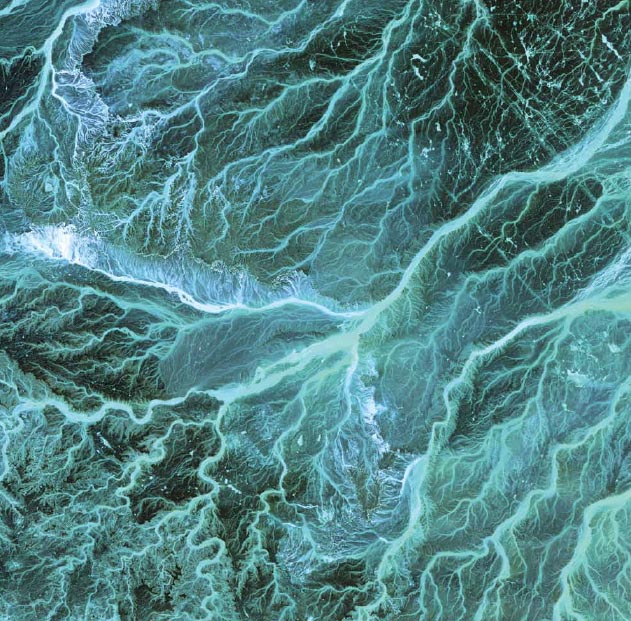
The Terra satellite captured this image of wadis in southeastern Jordan in 2001. The Arabic word wadi means a gulley or riverbed that is usually dry except after drenching, seasonal rains. In this image, meandering wadis have combined to form dense, branching networks across the stark, arid landscape.
Aleutian Clouds - Bering Sea
This looks identical to a water color painting.
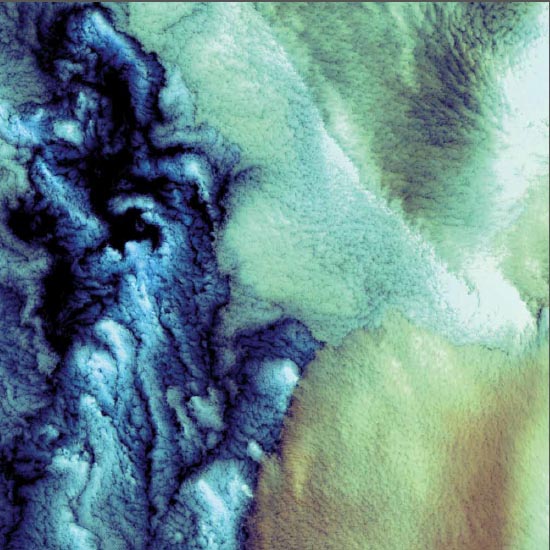
Clouds hover over the waters off the western Aleutian Islands, where fog, heavy rains, and high winds are common. While the clouds in this 2000 Landsat 7 image are structured differently, all the clouds shown are low, marine stratocumulus clouds, which often produce drizzle. The color variations are probably due to differences in the temperature and in the size of the water droplets that make up the clouds. The Aleutian Islands are part of the Pacific Ring of Fire. The archipelago curves out 1,800 kilometers from southwestern Alaska towards Russia’s Kamchatka Peninsula.
Alluvial Fan - China
Looks like a big clam shell
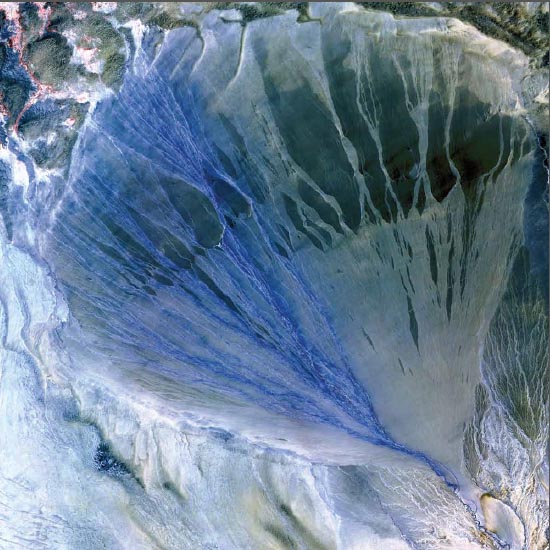
A vast alluvial fan unfolds across the desolate landscape between the Kunlun and Altun mountain ranges that form the southern border of the Taklimakan Desert in China’s Xinjiang Province. The fan is about 60 kilometers long and 55 kilometers wide at its broadest point. The left side is the active part of the fan. Water flowing down from the mountains in the many small streams appears blue in this 2002 image from the Terra satellite. Vegetation appears red and can be seen in the upper left corner of the image. Farmers take advantage of water at the foot of the fan to irrigate small fields. The “lumpy” terrain at the top of the image is composed of sand dunes at the edge of the Taklimakan, one of the largest sandy deserts on Earth. Shifting sand dunes, some reaching as high as 200 meters, cover more than 80 percent of the desert floor.
Anti-Atlas Mountains Morocco
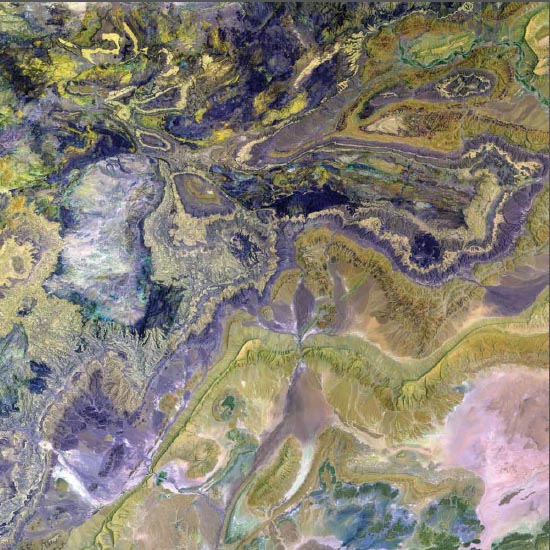
A part of the Atlas Mountains in northwest Africa, the Anti-Atlas range runs for several hundred kilometers. The range extends from the Atlantic Ocean in southwest Morocco toward the northeast, where it meets the High Atlas range closer to the Mediterranean Coast. The Anti-Atlas mountains formed as a result of continental collisions between 65 and 250 million years ago, which destroyed the then Tethys Ocean. The limestone, sandstone, claystone, and gypsum layers that formed the ocean bed were folded and crumpled to create the mountains. This Landsat 7 image from 2001 highlights some of the different rock types and illustrates the complex folding.
Bombetoka Bay Madagascar
Looks like a tree
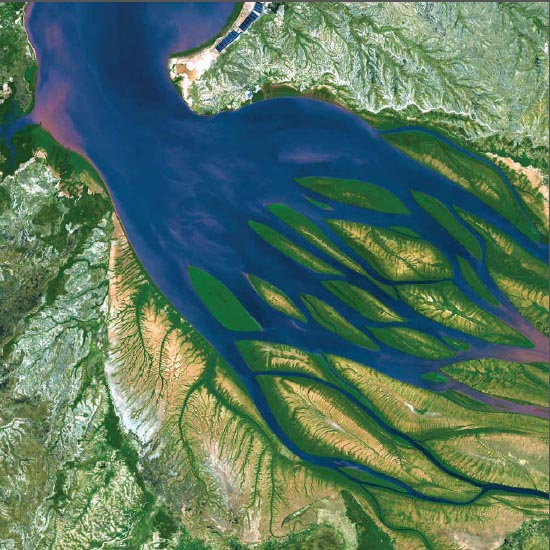
Bombetoka Bay is located on the northwestern coast of Madagascar near the city of Mahajanga, where the Betsiboka River flows into the Mozambique Channel. Numerous islands and sandbars have formed in the estuary due to sediment carried by the Betsiboka River as well as the push and pull of tides. The past few decades have witnessed a dramatic increase in the amount of sediment moved by the river and deposited in the estuary and offshore delta lobes, affecting agriculture, fisheries, and transportation in Mahajanga, one of Madagascar’s busiest seaports. In this Terra image from 2000, dense vegetation is deep green and water is sapphire and tinged with pink where sediment is particularly thick.
Erg Chech Algeria
Reminds me of tree bark
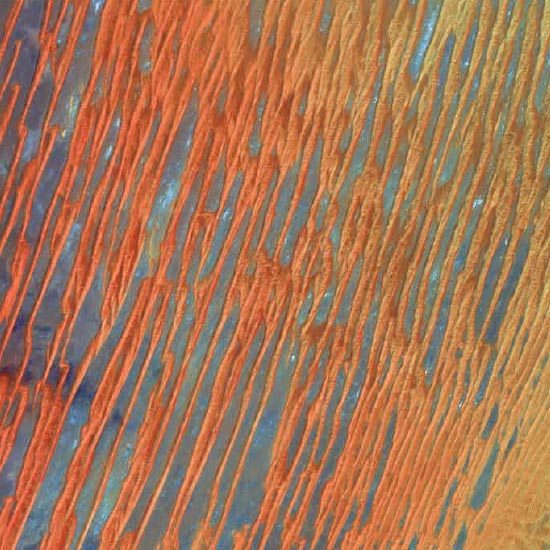
In this Landsat 7 image from 2003, the amber and caramel lattices seen are large, linear sand dunes in the Erg Chech dune sea located in the Sahara region of western Algeria. An erg, meaning dune field in Arabic, is a wide, flat area of desert covered with windblown sand and little vegetation cover. The dunes are formed when large amounts of transported sand are halted by topographic barriers. The largest dunes can take up to a million years to build. Ergs are also found on other celestial bodies such as Venus, Mars, and Saturn’s moon Titan.
www.nasa.gov...
Link to PDF : www.nasa.gov...
So I just thought I'd share this. These photos of our home are beautiful and interesting at the same time. It's weird how patterns tend to repeat themselves. There are 75 photos in the book, I only posted 6. The rest are in the free e-book linked above.
edit on 12-12-2012 by ShotGunRum because: (no reason given)
S/F OP! Thank you for posting this link! Earth is a beautiful place and these photos are a beautiful testament to that!
new topics
-
RIP Merrily Harpur British Big Cat Realist
Cryptozoology: 1 hours ago -
Australian mercenary caught and crying as he is a prisoner of war.
Other Current Events: 7 hours ago -
JILL BIDEN Wants JOE to Punish Democrats Who Forced Him to Leave Office in Disgrace on 1.20.2025.
2024 Elections: 8 hours ago -
Panamanian President-“every square meter” of the Panama Canal belongs to Panama.
New World Order: 8 hours ago -
NYPD arrests migrant who allegedly set woman on fire on subway train, watched her burn to death
Breaking Alternative News: 11 hours ago
5
